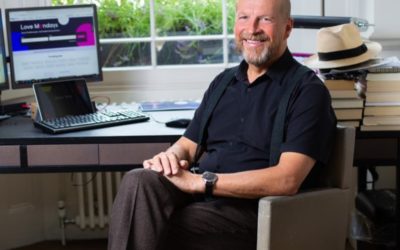Your CV is your first step on the path to a new job, and if you don’t get it right, your journey will end before it’s started. James Reed, in his book The 7 Second CV, argues that recruiters make up their minds within seven seconds of starting to read a CV as to whether the candidate is going to be put forward for an interview or be rejected. This seems daunting, but if you know what the recruiter wants, you can grab their attention and land that interview.
If you’re looking for a new role or just want to be prepared for any eventuality, these tips will help you craft your CV and show recruiters that you are the right person to solve their problem. The principles are the same, whether you are a new graduate or school-leaver or someone with many years’ experience. This article includes advice from both James Reed and from Andrea Raven-Hill, Regional Manager for Reed Education, who recently delivered a CV writing workshop for Keep Britain Working – both have decades of recruitment experience.
The basics
This might seem obvious, but you must include the following:
· Your name
· Contact details – phone number, email and address
These should go at the top of the CV. Almost as important:
· Choose a professional looking and readable font – not Comic Sans or something the recruiter will have to squint at to read.
· Make sure there are no spelling or grammatical mistakes. Ideally ask someone else to proof the CV too – they may have suggestions as well as picking up any typos you’ve missed.
· Keep the CV down to a maximum of two sides. If you can’t convince the recruiter that you could be the right person for the job in two sides, they are unlikely to change their mind on page 3.
Structure
Start the CV with a summary. This is often called a Personal Statement, although you don’t need to give it a label. This is where you cherry-pick the parts of the CV that you most want to bring to the recruiter’s attention – it’s the part of the CV that requires the most tailoring to the individual job that you are applying for. Andrea advises that you write this section last as it will draw on the rest of the CV.
The summary/Personal Statement should answer three questions, according to James Reed:
1. “Who are you?” – a statement about who you are, what you do and what your core values are
2. “What can you offer?” – what are the specific skills or experience that make you suitable for the role
3. “What are your career goals?” – how do your plans fit into the company
Keep the summary to a maximum of 150 words and try to show concrete achievements rather than just list buzzwords.
After the summary you need to start strongly with highlights at the top. Usually this means starting with your Work History in reverse chronological order (i.e. most recent job first). As well as the company name, dates of employment and job title for each role, you should also give details of your achievements. These should be measurable and relevant to the job you are applying for. Don’t just describe your general duties as they will mostly follow from the job title. If you have a long career, keep details of your earlier jobs to a minimum, unless there is something particularly relevant to the job that you are applying for. If you have a short career, you could include any volunteer work you have done, if you can link specific skills or qualities to the job you want.
If you are just starting out on your career, you might want to put your Education before your Work History, otherwise you will probably put it afterwards. Again, start with your most recent qualifications – especially professional qualifications. The more work experience you have, the less relevant your education will be and the less detail you need to put in, but, as Andrea says, if you don’t put it in at all, it will look odd. Emphasise anything that you can tie into the job – eg modules of your degree that are relevant to the industry or work placements.
You will also want to include a Skills section. Include both hard skills – ones that can be objectively measured – and soft skills, like teamwork, leadership and problem solving. Only include the hard skills that might be relevant for the job. The soft skills must be linked to evidence – show where you’ve put these skills into practice in your previous work, otherwise they will just be empty boasts. As James Reed says, “Tossing a random bunch of soft skills into your CV mix is a recipe for disaster, as recruiters are masters at ignoring them when they’re vaguely presented.”
You may want to include a Hobbies and Interests section. Once again, you should try to show these are relevant to your desired job – for example, if you coach a children’s football team, you could link this to leadership or organisation skills. If your hobbies are Netflix and “socialising with friends”, you are better off not including this section at all.
For some roles you may want to include a Social Media section – this would certainly be relevant to a PR role, for example. If you have an Instagram account about fashion and you’re applying for a job in the fashion industry, that would also be reason to include it. If your social media has nothing to do with work, best leave it out – and remember to check your privacy settings, as even if you don’t include your social media details, recruiters will be looking for your accounts.
What not to include
Any aspect of your personal life that is not directly relevant to the job should be omitted. Too much personal detail is at best distracting and at worst might prejudice the recruiter against you. So marital status, religion, age, gender, sexual orientation and ethnicity are all best left out.
Cover letter
Once you have finished your CV, you may also want to include a covering letter, if the application process allows it. It is even more essential to tailor the covering letter to the job than it is to tailor the CV – Andrea advises that if you don’t have the time to do the covering letter justice, don’t do one at all.
Andrea suggests finding out who the hiring manager is to give the letter a more personal touch – it immediately indicates that you have done some research. Give the company a call if the name of the manager isn’t on the advert.
The covering letter is where you can explicitly show that you know what the hiring company does, what they are looking for from a successful applicant, why you are suitable and what you can do for the company. Effectively it is pointing out the bits of your CV that the hirer should be looking at and telling them why you are the right person for the job.
Looking for more help?
You can watch Andrea’s CV writing workshop here.
Reed.co.uk have prepared some CV templates and also have a CV builder.
James Reed’s book, The 7 Second CV: How to land the interview, is available from Amazon and all good bookshops.
Good luck!







